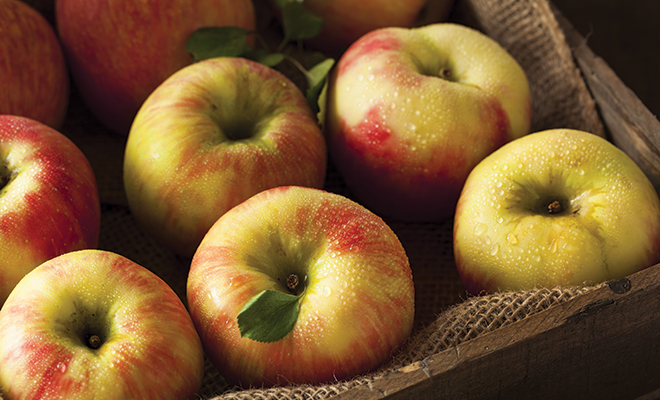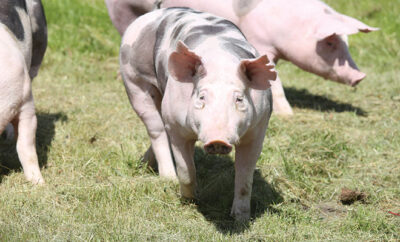
A Fruit’s Summer Fling
We each have our own private, sweet memory of our first summer love. Against a backdrop of fresh-mown grass, the heady scent of all flowering things, a sultry breeze in the summer sun, a warm and starry night, as sure as the sound of bees and the sight of the first butterfly, I remember that first, unexpected summer liaison. What I’m talking about is hybrid fruit, of course.
My culinary crush was a goofy-looking cantaloupe. Its rind had an exotic, alien quality, with none of the familiar orange and white netting of the ordinary melons in grocery stores or roadside stands. This fruit had a smooth, gray-green netting as unfamiliar as an ancient map of a European city. I was dubious about making a commitment, but I took a calculated risk.
Risky behavior is not always rewarded. In this case, slicing that cantaloupe was the beginning of a summer love affair. Its flavor surpassed that of any cantaloupe or honeydew I’d ever tasted, and the paper-thin rind produced an abundance of fruit. In my cantaloupe-intoxicated passion, I bought one of these on every trip to the store.
But, like any summer love, this one was destined to last only one season. The following year I waited patiently for its return. I hung out where we first met, week after week, playing it cool when the truth was that I could hardly wait for this delightful relationship to begin anew. But as time passed, reality set in. I had to admit that I’d been stood up in the produce aisle.
Anyone who has experienced a failed relationship wants to know why it had to end. In time, I sought out the produce manager to ask—what happened?
“Ma’am, it was a hybrid.”
What?
“Hybrids. Every year, in a field somewhere, something cross-pollinates. We’ll have a whole crop of good stuff. But it’s never there the next year.”
And so I learned that my summer fling had been the result of a summer fling of its own! Somewhere, a farmer unexpectedly had a couple of fields of cantaloupe. Fate, with help from the birds and the bees, helped produce a once-in-a-lifetime generation of cantaloupe that would never reproduce. It seemed like a tragedy of star-crossed lovers.
I remembered the old wives’ tales from serious gardeners and farmers in the family, people who faithfully composted their leftover harvest each year. They spoke of strange-looking vines and fruits emerging from the compost pile the following spring, things that were not quite cucumbers or cantaloupes but something in between; could it be a one-time hybrid? Modern science says no; certain hybrids like these are as elusive as unicorns. Cucumbers and squash do not cross-pollinate, nor do squash and melons.
But hybrid produce has existed as long as mankind has tilled soil and planted seeds. Fields of cantaloupe in ancient Sumeria were carried to Europe and beyond by wind, insects, merchant trade routes, armies in wartime and other travelers. They were cross-bred with muskmelon along the way. People still confuse a true cantaloupe (small and round, with a smooth, dark, netted rind) with its hybrid muskmelon cousins (larger, with deeper ridges).
The hybrid fruits and vegetables in groceries today were probably influenced most by commercial nurseryman Luther Burbank. As a plant breeder in the early 1900s, Burbank was responsible for introducing more than 200 varieties of fruit into American produce. He was not a scientist, but he used techniques such as cross-pollination, seed selection and grafting to bring new varieties of apples, strawberries, cherries, peaches, pears and more to the marketplace.
Hybridization should not be confused with GMOs, or genetically modified organisms. Hybrid plants occur in nature through cross-pollination. Some hybrids are the result of controlled pollination, more of an “arranged marriage” controlled by a plant breeder, as opposed to fields pollinated by the birds and the bees. One example is the seedless watermelon, which is a sterile fruit. In contrast, GMOs are unable to occur naturally, as they have components of altered DNA that change their very gene structure. One example of this is the Hawaiian rainbow papaya. When the papaya ringspot virus threatened to wipe out the harvest, DNA from the virus was transferred into papaya DNA, producing genetically modified fruit that was resistant to the disease.
Once exotic fruits are now ordinary; who knows what the hybrid future holds? Only the imagination of the creative and tasteful agriculturists and horticulturalists! ■
Sources: articles.latimes.com, huffingtonpost.com, fruitguys.com.
Exotics in the Grocery Aisle
• Cotton Candy grapes: A hybrid, seedless grape; embryo plants are grown in vitro.
• Honeycrisp apples: Macoun and Honeygold Apples.
• Pluots: Plum and apricot; its predecessor was the plumcot.
• Peacotum: Peach, apricot and plum cross.
• Rabbage: Cabbage crossed with radish.
• Tangelos: Tangerine and grapefruit hybrid.
• Nectacotum: Nectarine, apricot and plum cross.
• Boysenberries: Blackberry and raspberry







